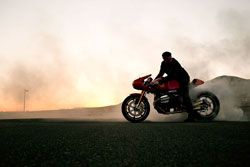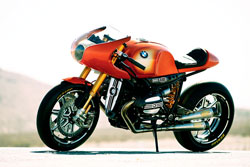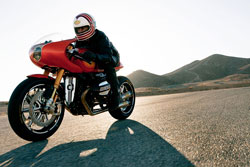
Roland Sands' Project 90 focused on aesthetics as well as performance.
|
At the ripe young age of five, Roland Sands embarked upon his first modification - custom painting his Team Murray bicycle. With time, the youngster's passion for "tricking stuff out" continued to grow. In fact he recalled modifying RC cars, watercraft, dirt bikes, and just about every other device that was within his reach and powered by a motor.
"I was always surrounded by two wheels and custom bikes," he recalled. "So I guess I was a natural."
With time his skills and abilities continued to grow, and at the age of 16 he began designing bikes that were available for consumption. In 2005, the designer/ builder proudly opened Roland Sands Design; including the earlier stages of his career, Sands has been in the business for 22-years. Throughout the years as a designer, he has remained steadfast to his commitment - "making ideas a reality."
Roland Sands' convictions to follow his commitment recently came to the forefront, when he was commissioned by BMW Motorrad to participate in "Project 90." The purpose of the project was two-fold. It would commemorate the company's 90th anniversary, while paying homage to the BMW R 90 S, a bike that was introduced to the market 40-years ago.
The original R 90 s was one of the fastest production bikes of its time, with a top speed of nearly 200 km-per-hour. It was a "perfect combination of form and function in a motorcycle development process." This bike epitomized aerodynamics, and is still revered my many motorcycle enthusiasts today.

Roland Sands Design was recently commissioned to design a bike paying homage to the BMW R 90 S, a bike introduced to the public 40-years ago.
|
That in mind, it was clear that BMW Motorrad wanted to keep many of the characteristics of the bike intact, but while incorporating some of the most up-to-date and radical modifications. It was a tall order, but nothing that Sands and the BMW representatives couldn't handle.
When asked his thoughts about being involved in the project, Sands said, "It was a good opportunity to show BMW what we can do, both on the motorcycle design, and product front, I was stoked to do it. Ola Stengard (head of design at BMW) went through what we wanted to do as a team. And Sylvain, also with BMW, sketched the design. When I saw the rendering, I got really excited to do it. Normally I render everything, so it was actually a relief to have someone else's sketches to work off of."
Referring to several representatives of the company, Sands continued, "We really worked together on all of the ideas and agreed on nearly everything. So it felt like I had a lot of freedom, even though it was just an illusion, because we really all wanted the same thing out of the project.
"We'd been working on ideas for a long time, he recalled. "It was probably six-months from idea to start."
When the idea finally came to fruition though, the team was ready to get the project underway and completed. In fact, within four months from the time BMW started to render, the bike was up and running.

Roland Sands and representatives of BMW completed project 90 in only four months, producing a bike that "embodies the ideas of the original while pushing toward the future."
|
Of this time period, Roland Sands was allotted two months to complete the build. Those of us not in the business of designing and building might consider a couple of months as ample time to wrap up the project. But to the contrary, many late hours would be dedicated to meeting the deadline. In fact, Sands was faced with the chore of designing, engineering and machining 18 individual parts. That's not including hours of body work.
While paying attention to aesthetics Roland Sands and the BMW team were also aware that performance would prove of greatest importance. Knowing optimal performance and reliability depended a great deal upon proper maintenance, they knew it was essential to ensure the engine remained contaminant free. That in mind, Sands fabricated an air filter from K&N filter components. "Referring to K&N products, he said, "They're the best in filtration."
All though the deadline was pressing, the designer had no intentions of doing anything but producing an awesome product in the time allotted. In turn, one of the highlights of the entire project for Sands was "Riding the bike on the racetrack after thrashing on it until 5:00 a.m.."
With the project behind him, Roland Sands finally has time to look back and savor the entire process. When asked the toughest aspect of the project, he recalled, "Working with a team that was across the ocean. But that ended up also being the easy part, as Ola Stengard is such a good guy and easy to work with.
Although there were challenges lurking here and there, the finished product brought with it many rewards. "I really like how everything works together," ensured Sands. Its a solid clash of vintage and modern tech. The finished product was an aggressive, race-minded approach to a traditional cafe' racer. It embodies the ideas of the original, while pushing toward the future." |
